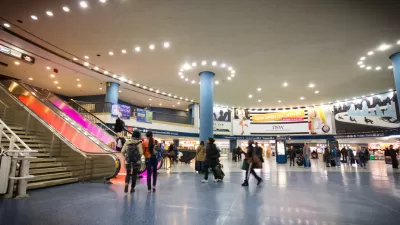Once again, chronic delays on New Jersey Transit's rail lines in and out of Manhattan serve as a reminder of Gov. Christie's ill fated decision to cancel replacement of the two aging Hudson River tunnels to Penn Station.
Just two weeks after The New York Times architectural critic, Michael Kimmelman wrote a featured article on the need to rebuild the 100-year-old Hudson River rail tunnels, known as Amtrak's Gateway Program, and warning of their vulnerability and high priority for replacement, Benjamin Mueller writes about just such an incident, though not confined to one day.
For the third day in a row, electrical problems in century-old rail tunnels under the Hudson River on Wednesday stymied the commutes of tens of thousands of New Jersey Transit riders, illustrating again the shortcomings of the region’s languishing infrastructure system.
"The delays... created chaos during the morning rush hour," writes Mueller. "The deterioration of the tunnel walls accelerated after Hurricane Sandy, as seawater and salt that inundated the tunnels ate away at concrete bench walls where the signal and power cables are held."
Power was shut down to both tubes of the Hudson River Tunnel around 5:45 a.m. [Wednesday] after a switch that controls a high-voltage cable malfunctioned, said Craig Schulz, a spokesman for Amtrak, which owns the tunnel.
Different problems with the same overhead catenary system also snarled New Jersey Transit commuting on Monday night and Tuesday morning. Both heat and brittle electrical systems could have played a role, but transportation experts said the problems pointed to broad failures to invest in repairs and build systems that could accommodate everyday glitches.
For New Jersey rail commuters going to Manhattan, the cancellation of the Access to the Region's Core (ARC) project by Gov. Chris Christie on October 7, 2010 followed by the devastation caused by Hurricane Sandy in late October two years later came as a one-two punch.
Transit advocates said that this week’s breakdowns, far from being an anomaly, laid bare the paralyzing effects of disruptions that could become common in the absence of quick action.
Mueller revisits the Christie's cancellation of ARC, writing that he "ordered that $3 billion from the Port Authority of New York and New Jersey set aside for the plan be redirected to other projects in New Jersey. Critics charged that his actions were politically motivated and allowed him to keep a campaign promise not to raise the gasoline tax."
Despite an independent federal report saying he exaggerated the costs, Mr. Christie defended the decision by saying he worried that the project would have unduly burdened taxpayers.
Amtrak, who is paid by New Jersey Transit to maintain the tunnels, issued a statement saying, “We apologize to all who are affected by these delays.”
The agency, which is in the process of upgrading signal and catenary systems on a 23-mile section of railroad from Trenton to New Brunswick, said such delays “stem from long-term underinvestment in the Northeast Corridor.”
In his July 8 piece that appeared The Arts section of The Times, Kimmelman starts with the Hudson tunnel problems, but like so many other ARC critics, delves into the problems associated with Penn Station, "the nation's busiest and most disgusting transit hub, not to mention a potential fire trap...But new tunnels aren't enough...The old tunnel plan, quashed by Governor Christie, skirted Penn Station, which posed problems."
Kimmelman goes on to describe plans for enlarging Penn Station, moving Madison Square Garden, and comparison to the new, soon-to-be-opened World Trade Center Transportation Hub, dubbed "the World’s Most Expensive Train Station."
Penn Station may be no Grand Central Station, but what's delaying commuters in and out of Manhattan is not a substandard terminal but decaying, century-old Hudson River tunnels.
FULL STORY: On Day 3 of Delays, New Jersey Transit’s Shortfalls Are Painfully Clear

Study: Maui’s Plan to Convert Vacation Rentals to Long-Term Housing Could Cause Nearly $1 Billion Economic Loss
The plan would reduce visitor accommodation by 25,% resulting in 1,900 jobs lost.

North Texas Transit Leaders Tout Benefits of TOD for Growing Region
At a summit focused on transit-oriented development, policymakers discussed how North Texas’ expanded light rail system can serve as a tool for economic growth.

Why Should We Subsidize Public Transportation?
Many public transit agencies face financial stress due to rising costs, declining fare revenue, and declining subsidies. Transit advocates must provide a strong business case for increasing public transit funding.

How to Make US Trains Faster
Changes to boarding platforms and a switch to electric trains could improve U.S. passenger rail service without the added cost of high-speed rail.

Columbia’s Revitalized ‘Loop’ Is a Hub for Local Entrepreneurs
A focus on small businesses is helping a commercial corridor in Columbia, Missouri thrive.

Invasive Insect Threatens Minnesota’s Ash Forests
The Emerald Ash Borer is a rapidly spreading invasive pest threatening Minnesota’s ash trees, and homeowners are encouraged to plant diverse replacement species, avoid moving ash firewood, and monitor for signs of infestation.
Urban Design for Planners 1: Software Tools
This six-course series explores essential urban design concepts using open source software and equips planners with the tools they need to participate fully in the urban design process.
Planning for Universal Design
Learn the tools for implementing Universal Design in planning regulations.
City of Santa Clarita
Ascent Environmental
Institute for Housing and Urban Development Studies (IHS)
City of Grandview
Harvard GSD Executive Education
Toledo-Lucas County Plan Commissions
Salt Lake City
NYU Wagner Graduate School of Public Service



























